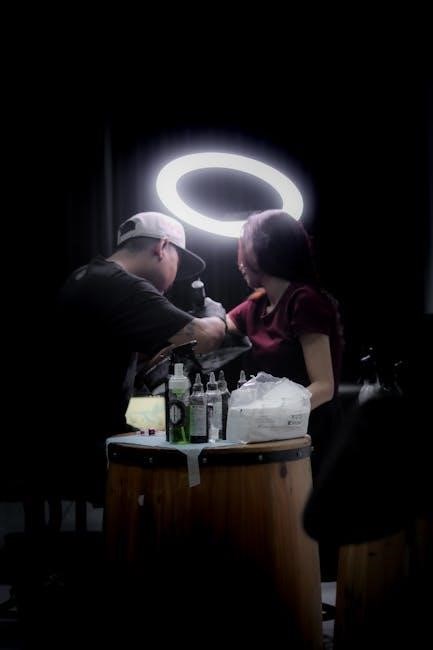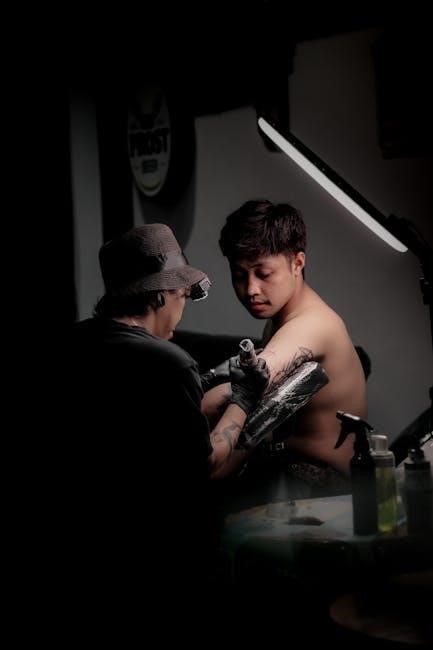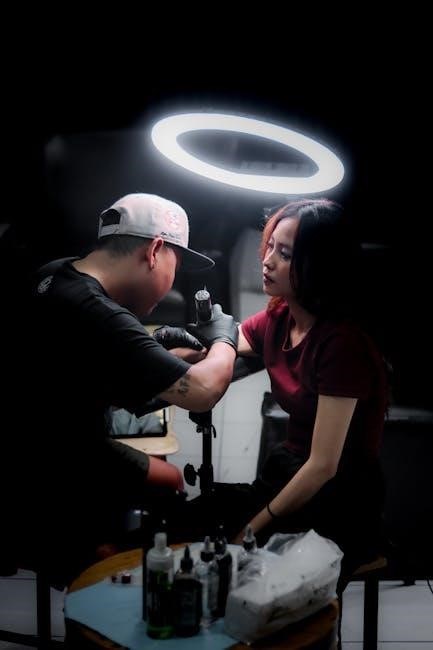
Immediate Steps After Getting a Tattoo
After getting a tattoo, keep it bandaged for 2-3 hours. Wash hands before touching the tattoo. Gently clean with mild soap and warm water immediately.
1.1 Keeping the Tattoo Bandaged
After getting a tattoo, it’s crucial to keep it bandaged for the first 2-3 hours to protect it from bacteria and contamination. Use the bandage provided by your tattoo artist, as it’s specifically designed for this purpose. Avoid touching the tattoo or removing the bandage prematurely, as this can introduce germs and delay healing. Once you remove the bandage, gently wash the tattoo with mild soap and warm water. Pat it dry with a clean towel. Avoid re-bandaging unless instructed by your artist, as the tattoo needs airflow to heal properly. Keep loose, clean clothing over the area to prevent irritation.

1.2 Washing Hands Before Touching the Tattoo
Washing your hands thoroughly before touching your new tattoo is essential to prevent infection. Use warm water and antibacterial soap, ensuring all surfaces of your hands are clean. Avoid using harsh or scented soaps that might irritate the skin. Pay special attention to areas under your nails and between fingers, as these often harbor bacteria. After washing, dry your hands completely with a clean towel. This step is crucial because your hands can carry germs that may lead to complications during the healing process. Always wash your hands before any interaction with the tattoo, including cleaning or applying moisturizer.
1.3 Initial Cleaning with Soap and Water
After removing the bandage, wash the tattoo with mild, unscented soap and lukewarm water. Use your hands to gently clean the area, avoiding scrubbing or harsh friction. Rinse thoroughly to remove any soap residue. Pat dry with a clean, soft cloth or let it air dry. Avoid using hot water, as it can irritate the skin. Clean the tattoo 2-3 times daily to prevent bacteria buildup. Never soak the tattoo in water during the initial healing phase. Avoid using scented soaps, exfoliating products, or harsh chemicals that could damage the tattoo or slow healing.
The First 48 Hours of Tattoo Aftercare
After removing the bandage, wash the tattoo with mild soap and warm water. Pat dry and apply a thin layer of recommended aftercare product.
2.1 Timeline for the First 48 Hours
Within the first 24 hours, keep the tattoo bandaged as instructed by your artist. After 24 hours, remove the bandage and wash the tattoo with mild soap and warm water. Gently pat dry. For the next 24 hours, avoid submerging the tattoo in water and keep it moisturized with a fragrance-free lotion. Avoid direct touch and ensure the area remains clean. This timeline ensures proper healing and minimizes the risk of infection or irritation. Stick to the aftercare routine strictly during this critical period for optimal results.
2.2 When to Remove the Bandage
After getting a tattoo, the bandage should remain on for 2-3 hours or until the tattoo artist recommends removal. Avoid removing it too early, as this can expose the tattoo to bacteria. Once removed, gently wash the tattoo with mild soap and warm water. Pat it dry with a clean towel. The bandage protects the tattoo from dirt and germs during the initial healing phase. If the bandage sticks, dampen it with water before removing to prevent pulling on the skin. Always follow the artist’s instructions for bandage removal to ensure proper healing and minimize risks of complications.

The First Week of Tattoo Healing
Wash the tattoo daily with mild soap and warm water. Avoid harsh products. Moisturize to keep skin hydrated. Gently handle peeling; avoid picking. Wear loose clothing to prevent irritation.
3.1 Washing the Tattoo Daily
Washing the tattoo daily is essential for proper healing. Use clean hands and mild, unscented soap with warm water. Gently massage the area, avoiding scrubbing or harsh friction. Rinse thoroughly to remove all soap residue. Pat dry with a clean towel, never rub. This process should be done twice a day to keep the tattoo clean and prevent infection. Avoid using hot water, as it can irritate the skin. Ensure the soap is fragrance-free to minimize the risk of allergic reactions. Consistent daily washing helps maintain a healthy environment for healing and prevents bacteria buildup.
3.2 Avoiding Harsh Soaps or Scented Products
When caring for your tattoo, avoid using harsh soaps or scented products, as they can irritate the skin and delay healing. Opt for mild, fragrance-free cleansers specifically designed for tattoos or sensitive skin. Harsh chemicals can strip the tattoo of its natural moisture, leading to dryness and potential complications. Instead, choose hypoallergenic or fragrance-free soap to cleanse the area gently. Avoid products containing alcohol, dyes, or artificial fragrances, as they may cause allergic reactions or dry out the tattoo. Natural alternatives like coconut oil or tattoo-specific aftercare creams are better for maintaining moisture without irritation. Always prioritize gentle care to promote proper healing and color retention.
3.3 Moisturizing the Tattoo
Moisturizing is essential for proper tattoo healing. After the first 48 hours, apply a fragrance-free, non-comedogenic lotion or specialized tattoo cream 2-3 times daily. This prevents dryness and cracking, promoting vibrant colors. Natural alternatives like coconut oil or aqueous creams can be used, but avoid petroleum-based products. Over-moisturizing can trap bacteria, so apply a thin layer. Continue moisturizing until the skin is fully healed, typically 2-4 weeks. This step ensures the tattoo stays hydrated, reducing peeling and scabbing. Always choose products recommended by professionals to avoid irritation or delays in healing.

The First Month of Tattoo Aftercare
Avoid touching the tattoo to prevent infection. Gently manage peeling skin and scabs. Keep the area moisturized with recommended products, avoiding tight clothing that may irritate.
4.1 Avoiding Touching the Tattoo
Touching the tattoo excessively can introduce bacteria, leading to infections. Even with clean hands, avoid unnecessary contact to prevent contamination. The tattoo is an open wound, and constant touching can disrupt the healing process. Use loose clothing to avoid irritation and avoid picking at peeling skin or scabs. Overhandling can cause friction, delaying recovery. Keep the tattoo moisturized to reduce dryness, but avoid touching it excessively. Patience is key; let the tattoo heal naturally without interference. This ensures proper healing and minimizes the risk of complications.
4.2 Dealing with Peeling Skin
Peeling skin is a normal part of the tattoo healing process, typically occurring within the first week. Avoid picking at the skin, as this can cause scarring or infections. Gently wash the tattoo with mild soap and warm water to remove any loose skin. Apply a fragrance-free, non-comedogenic moisturizer to keep the area hydrated. Avoid harsh products or exfoliants that may irritate the skin. If peeling is excessive or accompanied by redness or swelling, consult a professional. Keep the tattoo moisturized to promote healing and prevent further irritation. Pat dry gently after washing to avoid removing healing skin layers.
4.3 Managing Scabbing or Crusting
Scabbing or crusting is a natural part of the healing process. Avoid picking at scabs, as this can lead to infection or damage. Gently wash the area with mild soap and warm water to keep it clean. Apply a thin layer of recommended aftercare cream to keep the skin moist and promote healing. Avoid tight clothing that may irritate the scabs. If scabbing persists beyond two weeks or shows signs of infection (redness, swelling, or pus), consult a medical professional. Proper care ensures scabs fall off naturally, revealing healthy, healed skin underneath.
General Tattoo Aftercare Tips
- Avoid direct sun exposure to prevent fading and promote healing.
- Keep the tattoo moisturized with recommended products to maintain hydration.
- Wear loose, comfortable clothing to reduce irritation and friction.
- Avoid swimming or soaking in water until fully healed.
5.1 Avoiding Direct Sun Exposure
Avoiding direct sun exposure is crucial during the healing process. UV rays can cause fading, blurring, and damage to the tattoo. Use broad-spectrum sunscreen (SPF 30+) when outdoors. Wait until the tattoo is fully healed (2-3 weeks) before sun exposure. Even after healing, protect your tattoo with sunscreen or clothing to maintain its vibrancy and prevent long-term damage. Prolonged sun exposure can lead to premature aging of the skin and tattoo ink. Always prioritize sun protection to preserve the quality and appearance of your tattoo.
5.2 Keeping the Tattoo Moisturized
Moisturizing is crucial for tattoo healing. Use a fragrance-free, non-comedogenic lotion 2-3 times daily. Avoid petroleum-based products. Apply gently, ensuring the tattoo stays hydrated without over-saturating. This prevents cracking and peeling, promoting vibrant colors and smooth healing. Consistency is key to avoid dryness and discomfort. Always choose products recommended by your artist for best results.
5.3 Wearing Loose, Comfortable Clothing
Wearing loose, comfortable clothing is essential during the healing process. Tight clothes can rub against the tattoo, causing irritation or even damage. Opt for breathable fabrics like cotton to allow proper airflow, reducing the risk of moisture buildup. Avoid restrictive clothing that may cause friction, as this can lead to discomfort or prolonged healing. Change your clothes daily to maintain hygiene and prevent bacteria from accumulating near the tattoo. Loose clothing also helps prevent accidental scratching or abrasions, which can compromise the tattoo’s integrity. By choosing comfortable attire, you ensure a smoother recovery and protect your tattoo from external stressors.
5.4 Avoiding Swimming or Soaking
Swimming or soaking in water should be avoided during the initial healing stages of a tattoo. Submerging the tattoo in water increases the risk of bacterial infections, as pools, hot tubs, and even bathtubs can harbor harmful bacteria. Additionally, soaking can soften the scabs that form, potentially causing the ink to fade or the tattoo to heal unevenly. It’s best to avoid swimming for at least 2-3 weeks after getting a tattoo, or until it has fully healed. Stick to short showers and pat the tattoo dry with a clean towel to minimize moisture exposure.
Healing Stages of a Tattoo
A tattoo heals in three stages: inflammation, new skin formation, and final healing. Each stage requires proper care to ensure optimal results and minimize complications.
6.1 Inflammatory Phase
The inflammatory phase begins immediately after tattooing and lasts a few days. It’s characterized by redness, swelling, and tenderness around the tattooed area. This reaction is normal as the skin responds to the trauma of needle punctures. To manage this phase, keep the tattoo clean with mild soap and water. Avoid tight clothing that may irritate the skin. Refrain from picking at scabs or peeling skin, as this can lead to further inflammation or infection. Use gentle, fragrance-free products to soothe the area. Pat dry with a clean towel after washing to prevent bacteria buildup. This phase is crucial for proper healing.
6.2 New Skin Formation
During the new skin formation phase, the tattooed area begins to regenerate. The skin starts to repair itself, forming a protective barrier. It’s crucial to keep the area moisturized to prevent cracking. Avoid harsh products and tight clothing to allow proper healing. Use recommended aftercare creams or natural alternatives like coconut oil to support skin regeneration. Avoid direct sun exposure and swimming to prevent irritation. This stage is vital for the tattoo’s appearance and longevity. Proper care ensures the skin heals evenly and the ink remains vibrant. Consistency in aftercare routines will help the tattoo transition smoothly into the final healing phase.
6.3 Final Healing and Touch-Up
The final healing stage occurs after 4-6 weeks. The tattoo is fully healed, but touch-ups may be needed. Wait at least 2 months before scheduling a touch-up. During this phase, the tattoo settles, and colors stabilize. Proper aftercare ensures vibrant results. Keep the area moisturized to maintain skin health. Avoid direct sun exposure to prevent fading. If minor scabbing or peeling persists, continue gentle care. Consult your tattoo artist for touch-up advice. Once healed, long-term care involves protecting the tattoo from UV rays and maintaining skin hydration. Your artist may provide final recommendations for optimal appearance. Ensure to follow their guidance for the best outcome.
Common Mistakes to Avoid

- Over-washing the tattoo, which can strip natural moisture.
- Neglecting to moisturize, leading to dry, cracked skin;
- Wearing tight clothing that irritates the tattoo.
7.1 Over-Washing the Tattoo
Over-washing the tattoo can strip it of its natural moisture, leading to dryness, irritation, and delayed healing. Stick to washing the tattoo 2-3 times daily with mild soap and water. Avoid harsh scrubbing or using hot water, as this can damage the skin. Excessive washing can disrupt the healing process and cause unnecessary stress to the tattooed area. If you notice redness, irritation, or scabbing due to over-washing, reduce the frequency and apply a thin layer of moisturizer. Always follow the aftercare instructions provided by your tattoo artist to avoid such mistakes. Proper balance is key for a healthy recovery.
7.2 Neglecting to Moisturize
Neglecting to moisturize is a common mistake that can hinder the tattoo healing process. Without proper hydration, the skin may become dry, itchy, or even crack, leading to discomfort and potential damage to the tattoo. Moisturizing helps maintain the skin’s natural barrier, promoting a smooth recovery. Use a fragrance-free, non-comedogenic lotion or cream recommended by your tattoo artist. Avoid over-moisturizing, as this can clog pores and delay healing. Consistency is key—apply moisturizer 2-3 times daily or whenever the skin feels dry. Proper hydration ensures the tattoo heals evenly and retains its vibrant appearance. Always prioritize moisturizing to avoid unnecessary complications during the healing process.
7.3 Wearing Tight Clothing
Wearing tight clothing over a fresh tattoo can cause friction, leading to irritation and potential damage. Tight fabrics may rub against the tattoo, causing discomfort and delaying healing. This friction can also lead to scabbing or blistering, increasing the risk of complications. Additionally, tight clothing can trap bacteria and moisture, creating an environment for infection. It’s essential to opt for loose, breathable clothing that allows the skin to heal without obstruction. Avoiding tight clothing helps prevent irritation and promotes a smoother recovery process. Always prioritize comfort and proper airflow to ensure your tattoo heals evenly and without issues.

Recommended Products for Tattoo Aftercare
Use tattoo-specific aftercare creams or ointments. Natural alternatives like coconut oil or aquaphor are effective. Avoid harsh or scented products that may irritate the skin.
8.1 Tattoo-Specific Aftercare Creams
Tattoo-specific aftercare creams are formulated to promote healing and maintain ink vibrancy. Look for products rich in vitamins A and E, panthenol, or aloe vera for soothing and moisturizing. Avoid creams with harsh chemicals, fragrances, or dyes, as these can irritate the skin. Popular options include Aquaphor Healing Ointment and Neosporin Tattoo Healing Cream. These products are designed to keep the tattoo moisturized without clogging pores. Apply a thin layer 2-3 times daily, as over-application can trap bacteria. Always choose fragrance-free, non-comedogenic options to prevent allergic reactions. Avoid using Vaseline or petroleum-based products, as they can hinder the healing process. Follow your tattoo artist’s recommendations for best results.
8.2 Natural Alternatives Like Coconut Oil
Coconut oil is a popular natural alternative for tattoo aftercare due to its moisturizing and antimicrobial properties. It helps soothe irritation and promotes healing without harsh chemicals. Apply a thin layer after cleaning the tattoo, ensuring it’s fully absorbed. Avoid over-application to prevent clogging pores. Coconut oil is gentle and suitable for sensitive skin, making it an excellent choice for maintaining tattoo health. For best results, use pure, unrefined coconut oil and avoid mixing with other products. Always patch test on a small area first to check for any adverse reactions. This natural remedy supports the tattoo’s healing process effectively.
8.3 Avoiding Certain Products
When caring for a new tattoo, avoid harsh soaps, scented lotions, and petroleum-based products, as they can irritate the skin and delay healing. Refrain from using Neosporin or similar ointments, as they may cause allergic reactions or hinder the tattoo’s natural healing process. Products containing alcohol or artificial fragrances should also be avoided, as they can dry out the tattoo and lead to discomfort. Always opt for fragrance-free, gentle cleansers and moisturizers specifically designed for tattoo aftercare. Consult your tattoo artist for recommendations on safe and effective products to use during the healing period.
When to Seek Medical Help
Seek medical help if you notice signs of infection, such as redness, swelling, pus, or fever. Consult a doctor if healing is delayed or unusual reactions occur.

9.1 Signs of Infection
Signs of infection include redness, swelling, increased pain, or discharge around the tattoo. Other indicators are fever, chills, or pus. If the tattoo becomes warm to the touch or develops red streaks, seek medical help immediately. Proper aftercare reduces infection risks, but monitor for unusual symptoms. Keep the area clean and moisturized to prevent bacteria growth. If symptoms persist or worsen, consult a healthcare professional without delay. Early treatment is crucial to avoid complications. Always prioritize hygiene and follow aftercare instructions carefully to minimize infection risks.
9.2 When to Consult a Professional
Consult a professional if you notice signs of infection, such as increased redness, swelling, or discharge. Seek advice if healing seems delayed or unusual. Professionals can address concerns like scarring or improper healing. They provide personalized guidance and ensure proper aftercare. Don’t hesitate to reach out if unsure about any symptoms or care steps. Timely consultation prevents complications and promotes optimal healing. Always trust a professional’s expertise for tattoo aftercare to avoid long-term damage or aesthetic issues. Regular check-ins ensure your tattoo heals beautifully and safely. Remember, professionals are there to help you achieve the best results for your new ink.

Printable Tattoo Aftercare Instructions
Printable guides provide a clear, organized plan for healing. Include timelines, product recommendations, and care tips to ensure proper healing and minimize complications at home.
10.1 Creating a Printable Checklist
A printable tattoo aftercare checklist ensures you stay organized during the healing process. Include daily tasks like washing the tattoo with mild soap and water, applying recommended moisturizers, and avoiding direct sun exposure. Add specific timelines, such as when to remove the initial bandage and how often to moisturize. List products to avoid, like harsh soaps or scented lotions. Incorporate tips from your tattoo artist and space for notes. Use bullet points or checkboxes for clarity. This tool helps track progress and prevents mistakes, ensuring proper healing. Print it on durable paper and keep it handy for quick reference during recovery.
10.2 Including Artist Recommendations
Many tattoo artists provide personalized aftercare instructions tailored to their work. Including these recommendations in your printable guide ensures the advice is specific and trusted. Ask your artist for their preferred products or techniques. They may suggest specific creams, ointments, or natural alternatives. Including their contact information or a quote can add credibility. This section should highlight the importance of following professional advice, as they understand the healing process best. By incorporating their insights, the guide becomes more comprehensive and reassuring for the client. This collaboration ensures the aftercare routine aligns with the artist’s expertise, promoting better healing outcomes.
10.3 Where to Find Printable Templates
Printable tattoo aftercare templates can be found on platforms like Pinterest, Etsy, and Google Docs. Many tattoo shops offer custom-designed PDFs for clients. Websites specializing in health and wellness often provide free downloadable guides. Online marketplaces like Etsy sell professionally designed templates that can be personalized. Additionally, tattoo artists may share their own aftercare checklists on their websites or social media. For a more generic option, Google Docs and Canva offer editable templates that can be tailored to specific needs. These resources ensure you can find or create a printable guide that suits your aftercare requirements perfectly.

Frequently Asked Questions
How long does healing take? Typically 2-3 weeks. Can I use Neosporin? Generally not recommended. Is peeling normal? Yes, it’s part of the healing process.
11.1 How Long Does Healing Take?

The healing time for a tattoo varies, typically taking 2-3 weeks for the surface to heal. However, full recovery can take up to 6 months. The first few days are crucial, as the tattoo is most sensitive. After 1-2 weeks, the tattoo begins to peel, and by 3-4 weeks, it starts to look fully healed. Individual factors like skin type and aftercare practices can influence the timeline. Proper care, such as keeping the tattoo clean and moisturized, ensures faster healing. It’s important to follow aftercare instructions to avoid complications. Touch-ups are usually scheduled after the tattoo is fully healed, around 6-8 weeks.
11.2 Can I Use Neosporin on My Tattoo?
Using Neosporin on a new tattoo is generally not recommended. While it is an antibiotic ointment, it can cause allergic reactions or irritation in some individuals. Many tattoo artists advise against it, as it may delay healing or lead to unwanted skin reactions. Instead, opt for fragrance-free, non-comedogenic moisturizers or tattoo-specific aftercare products. If you experience signs of infection, consult a healthcare professional for guidance. Always prioritize products recommended by your tattoo artist to ensure proper healing and avoid complications.
11.3 Is It Normal for a Tattoo to Peel?
Yes, it is normal for a tattoo to peel during the healing process. Peeling typically occurs within the first week to 10 days after getting inked. This is part of the skin’s natural healing cycle, as the top layer sheds to reveal new skin underneath. The peeling may resemble dry, flaky skin or small patches. It’s important to keep the tattoo moisturized during this phase to prevent excessive dryness and promote smooth healing. Avoid picking at the peeling skin, as this can damage the tattoo and lead to longer healing times or potential scarring. Proper care ensures the tattoo heals evenly and retains its vibrant appearance.